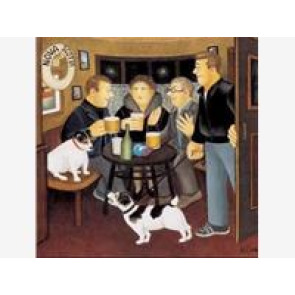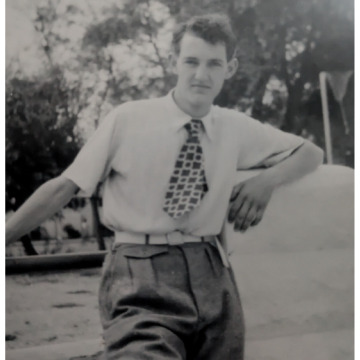BERYL COOKOBE, who died on 28 May, 2008, aged 82, was the bashful British artist whose jovial characters reflected the innocent joys of provincial life, from hen nights to shoe shops, casinos to cafes, and strip clubs to tennis lawns.Journalists were fond of describing her subjects using the polite euphemism ‘larger than life’, or quoting Victoria Wood’s pithy summation, "Rubens with jokes". Meanwhile some critics dismissed her as little more than a postcard humourist and it was easy to see why when most of her work was based on the people of Plymouth.But her colourful portrayals of overweight, middle-aged people getting themselves into trouble captured something in the British public imagination, something that had perhaps been missing since the heyday of holiday camps and music halls, and something that she perhaps felt was missing from her own life.Eleanor Beryl Cook was born on 10 September, 1926, in Surrey. She showed little talent at school, in painting or otherwise, and left at 14 to work in various jobs, including spending time on stage in London.In 1946 she married John, a childhood friend and former Merchant Navy seaman. For several years they ran a jazz pub in Bristol and then moved to Southern Rhodesia shortly after the birth of their son, also called John.Her career began by chance while in Africa when she was painting with her son using a children’s art set. Hangover, her first painting, remained in her house throughout her life. When the family returned to England in 1963 she decided to make some paintings to decorate their new cottage. Amusingly she had originally intended to mimic Stanley Spencer’s macabre figures. Though she failed with this goal, she was entertained by her efforts.She and her husband ran a boarding house in Plymouth and the couple would spend time in the local pubs and clubs watching the performers who stayed with them. One favourite haunt was a pub called The Dolphin where Mrs Cook would sit and observe the local characters, making sketches on postcards inside her handbag so she would not be seen.She was drawn to those more extroverted than herself and reflected vibrant personalities with gaudy outfits and shoes she never had enough confidence to wear herself. The imposing physiques of her characters were an obvious metaphor for larger personas.Though she started out painting for her own amusement, a friend persuaded her, after much cajoling, to give him a few of her paintings to sell in his antique shop and they went quickly. Over the next decade her popularity in the area grew and she became something of a local celebrity.Eventually word reached the Plymouth Art Centre which staged her first exhibition in 1975. Sunday Times Magazine covered the show and put her on the front cover, giving her national exposure for the first time. The following year she was exhibited again at the Portal Gallery in London. A Southbank Show film in 1979 increased her renown further.Beryl Cook’s paintings portray her as an outsider looking in: a self-portrait showed her alone and serene in pastels, while other women and men would be in boisterous groups, exposing flesh as they boarded buses and taxis or partied the night away."I love to see people enjoying themselves," she once explained. "That’s my greatest inspiration. I can't do that myself. I'd really like to be the one singing and dancing while everybody was sitting admiring me, but I can't do it. But my contribution to it all, to the fun, is my paintings."The incredible sales of her work during the ’80s and ’90s made her arguably Britain’s most successful and popular contemporary artist, much to the chagrin of many in the art world. Scorn was poured on her Carry On humour, but every column inch of indictment would naturally be accompanied by examples of her work, giving her further exposure and increasing her popularity.She respectfully painted the Queen twice on jubilees, once holding a corgi, and once dancing with Prince Phillip. She was given the OBE in 1995. In 2004 Tiger Aspect made two half-hour animated films based on her work which were voiced by Dawn French, Rosemary Leach, Timothy Spall and Alison Steadman and broadcast on BBC1.She remained shy and reserved throughout her life, though her success allowed her to travel from her Plymouth home to Europe and the Americas, finding more materials for her paintings. She rarely gave interviews and appeared on television only once after her Southbank Show profile. Nevertheless, she had an engaging personality and witty turn of phrase – in one typically self-depreciating newspaper interview she claimed she painted big ladies because "I don’t like doing backgrounds".She died peacefully at her home with her husband by her side, just a few years after retiring as a professional painter due to bad eyesight, though she continued to paint for her own enjoyment. "I now paint very slow and very rough," she said in one of her final interviews. "But it’s always been rough and slow so there's not an awful lot of difference."
Keep me informed of updates






